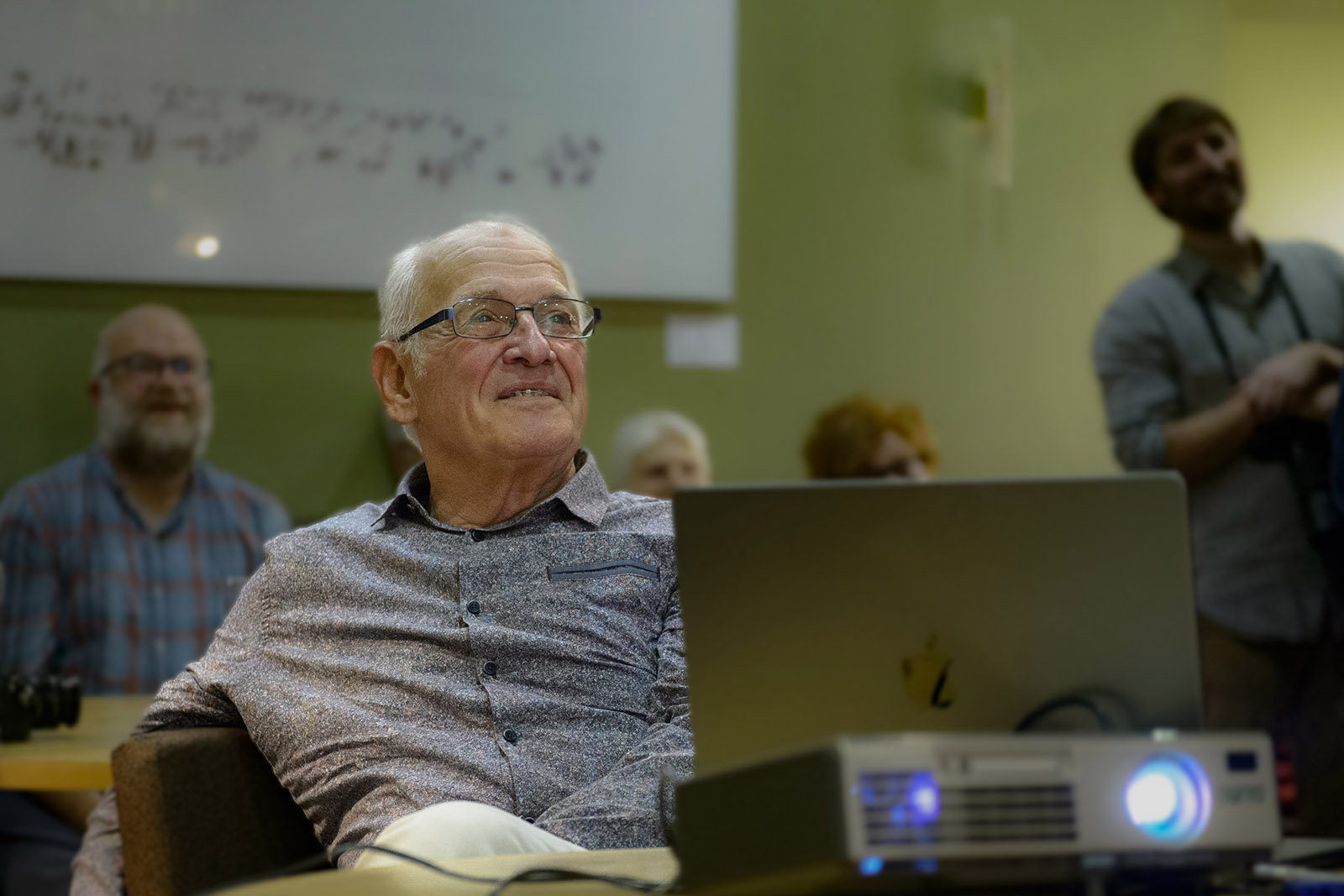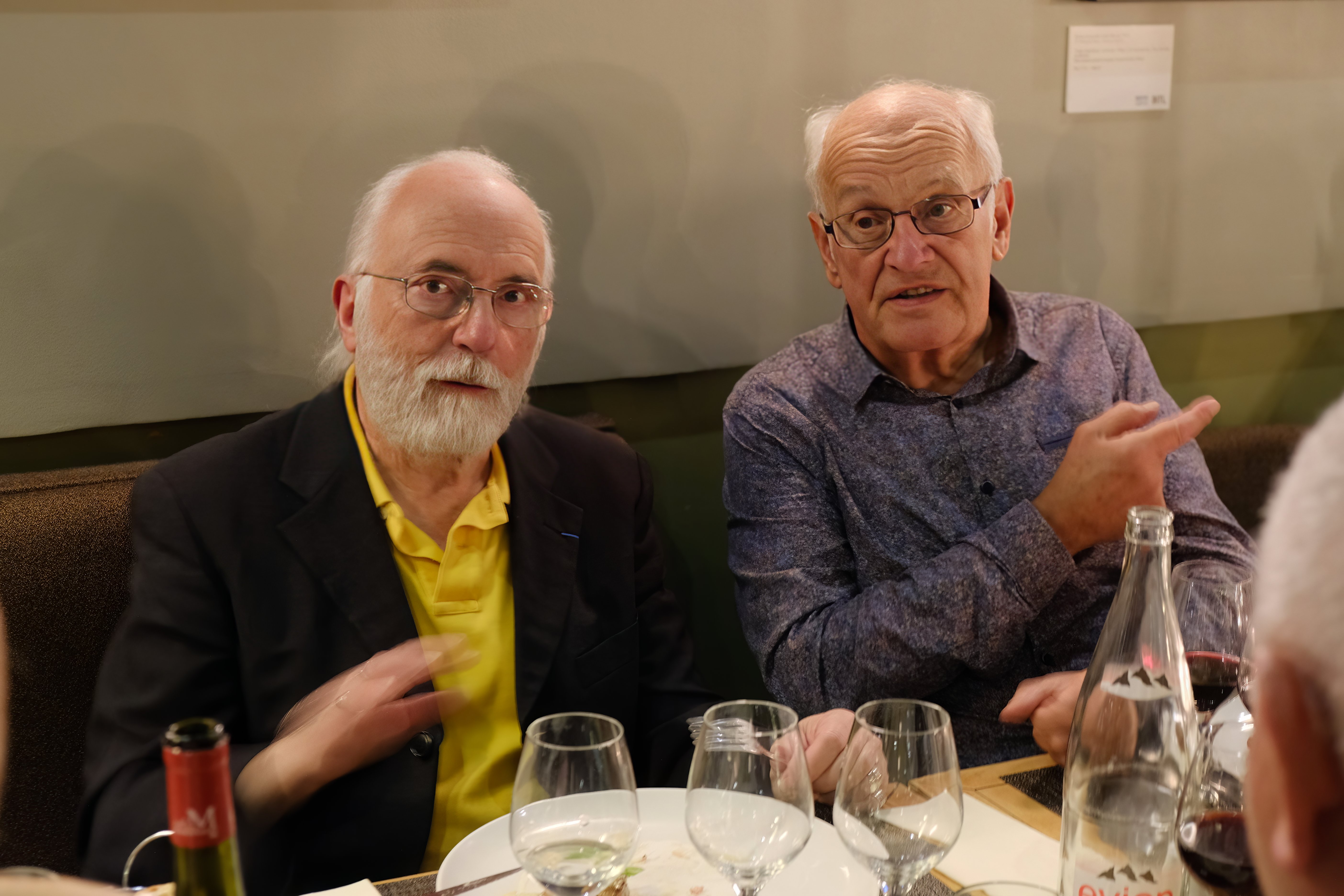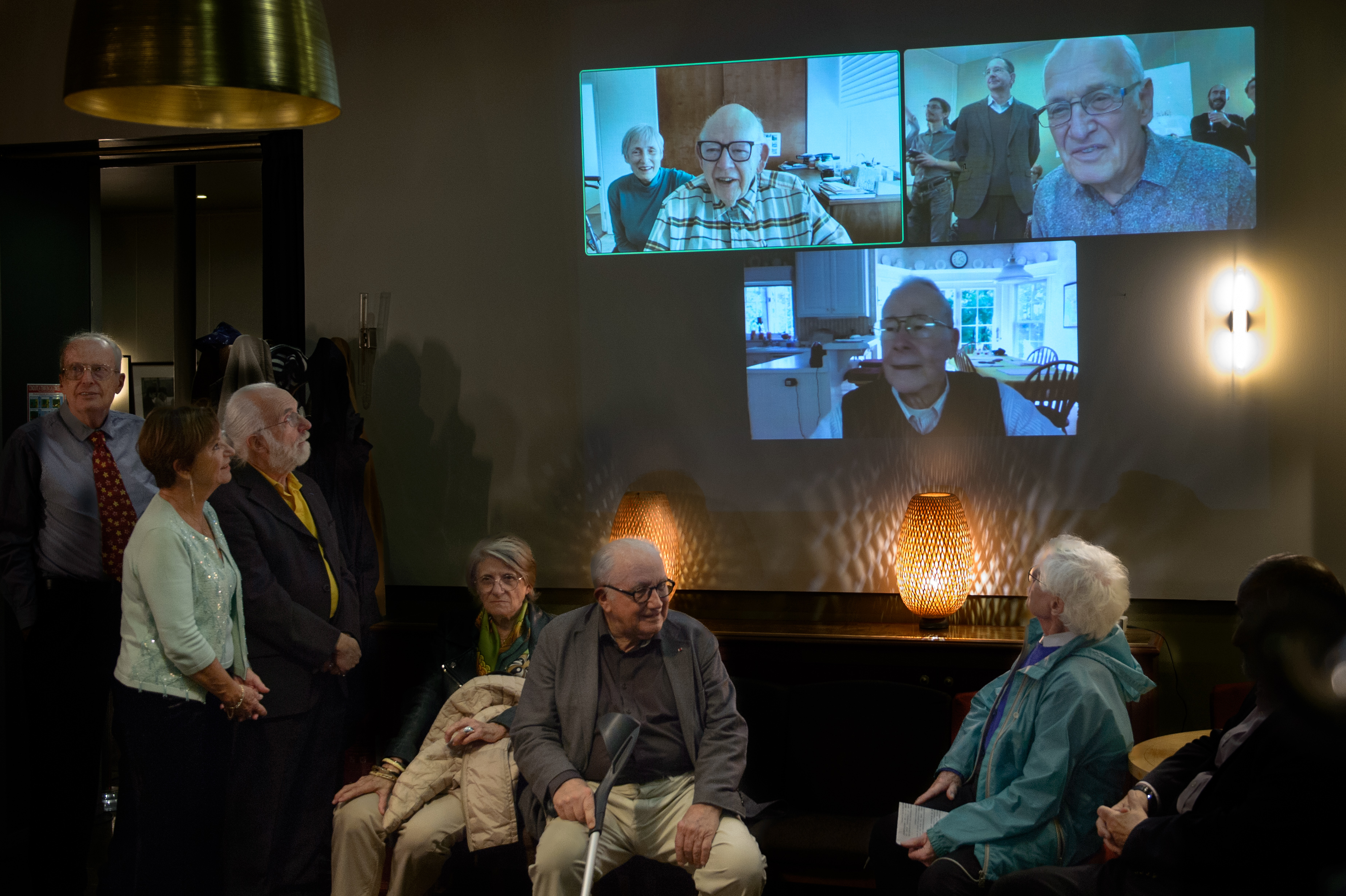80 YEARS OF ALFRED VIDAL-MADJAR: A CAREER FULL OF DISCOVERIES
At the end of 2022, researchers from European laboratories, including students he trained, came together to celebrate the 80th birthday of Alfred Vidal-Madjar, researcher emeritus at the Institut d’astrophysique de Paris. During this celebration, many people spoke to honor the remarkable career of this researcher who made his mark in French astrophysics, from the pioneering experiments in space exploration in the early 1970s to the observations of exoplanets with the most powerful instruments of the 2020s. Was underlined not only the originality of the research carried out by Alfred Vidal-Madjar with a number of successes and great firsts, but also the spirit of initiative which led him to tackle new subjects, conducive to discoveries, without a priori and with the pleasure of constantly questioning oneself.
 The reaction of Alfred Vidal-Madjar, emeritus researcher at the Institut d’astrophysique de Paris, to the screening retracing his career.
The reaction of Alfred Vidal-Madjar, emeritus researcher at the Institut d’astrophysique de Paris, to the screening retracing his career.
Credit: J. Mouette
Alfred Vidal-Madjar started his research under the direction of Jacques-Emile Blamont (then director of the Aeronomy Service of the CNRS, located in Verrières-le-Buisson), with the first space observations of the Earth's upper atmosphere using the hydrogen Lyman-alpha line in the far ultraviolet measured with an experiment on board the satellite OSO 5 (from the Orbiting Solar Observatory program) launched in 19691,2,3. Then knowing that this famous Lyman-alpha line also existed for the heavy isotope of hydrogen formed during the Big Bang, deuterium, Alfred Vidal-Madjar proposed to observe it in the interstellar medium4, using the Copernicus satellite. Lyman Spitzer, Chairman of the Department of Astronomy at Princeton University, who piloted this space observatory, was very surprised to see this observation proposal reach him not only because there was no guest observers program (in English GO for Guest Observer) at that time, but also because his group had not thought of it. Thanks to Roger-Maurice Bonnet (then director of the Stellar and Planetary Physics Laboratory, located in Verrières-le-Buisson) who had set up one of the first GO programs on the French experiment aboard NASA's OSO 8 satellite, it was possible to get a similar GO program implemented on the Copernicus satellite, which Don York had become responsible for, ultimately providing access to this unique deuterium data. Since deuterium is a tracer of the baryonic density of the Universe and of the chemical evolution of galaxies, when Alfred Vidal-Madjar joined IAP in 1984, invited by its director, Jean Audouze, he led in strong interaction with the latter5,6,7, numerous observation campaigns to measure the abundance of deuterium which, with added complexity, appeared to be inhomogeneous8,9. Another method of observing interstellar deuterium10 was subsequently proposed by Guillaume Hébrard. Another light element, lithium, whose abundance and isotopic ratio represent other indicators of primordial nucleosynthesis and stellar evolution, has also been the subject of major observation campaigns on the ground at very high spectral resolution11, carried out with Martin Lemoine to diversify observational research in this field associated with the evaluation of the baryon content of the Universe. The question of deuterium has thus become one of the major objectives of the FUSE (Far Ultraviolet Spectroscopic Explorer) space mission, developed by NASA in collaboration with the French space agency, CNES and the Canadian space agency, CSA12. FUSE was launched on June 24, 1999 and thanks to the strong participation of CNES in the development of holographic networks, a unique know-how in France of the Jobin-Yvon Company, Alfred Vidal-Madjar was naturally appointed co-investigator (Co -I) of the mission.
 Alfred Vidal-Madjar, accompanied by his colleague Roger Ferlet, with whom he conducted numerous observation campaigns to measure the abundance of deuterium.
Alfred Vidal-Madjar, accompanied by his colleague Roger Ferlet, with whom he conducted numerous observation campaigns to measure the abundance of deuterium.
Credit: A. Lecavelier
Alfred Vidal-Madjar, as early as 1978, proposed the existence of a very close interstellar cloud towards which the Sun and its entire System would be in the process of plunging5 (see Fred Hoyle's novel: “The black cloud”). Intense observation campaigns on the ground and from space then made it possible to explore the structure of the local interstellar medium and to discover the "Local Interstellar Cloud" (LIC) did indeed exist, and that other international teams have continued to observe. The LIC is now well characterized. It was during one of these campaigns that the famous and brilliant supernova 1987A occurred, visible to the naked eye, which allowed the detailed study of an intergalactic medium between the Milky Way and the Large Cloud of Magellan13. Subsequently other intergalactic environments have also been probed towards quasars in terms of deuterium abundance.
One cannot evoke the career and the discoveries of Alfred Vidal-Madjar without mentioning the star Beta Pictoris and the discovery of its exocomets. It all started in October 1984 with the first observations, again by spectroscopy, of the gaseous component of the circumstellar disk of Beta Pictoris, the image of which had just been published14. Then Alfred Vidal-Madjar, Roger Ferlet and Lew Hobbs, noted rapid variations in the spectra of this particular star. It took a lot of imagination to propose the idea in 1987 that we observed the passage of exocomets in front of Beta Pictoris15 (which we call “transits”). Despite the many original observational and theoretical arguments16 developed with Hervé Beust and Anne-Marie Lagrange, it also took a long time for this idea to finally be accepted, thanks in particular to the remarkable observations of exocomets17,18, carried out by Flavien Kiefer and Alain Lecavelier des Etangs.
Another major observation was made during photometric monitoring of the star Beta Pictoris: a strange and very significant occultation was detected in 198119 thanks to Christian Nitschelm and interpreted by Alain Lecavelier des Etangs as a possible transit either of a giant planet, or of a gigantic comet in front of the star. Since then, Anne-Marie Lagrange has discovered two planets in orbit around Beta Pictoris20,21, but which do not correspond to the 1981 event. An explanation has yet to be found.
These results on exocomets anticipated by eight years the discovery of the first exoplanet around a star similar to the Sun. Thirty-five years later, hundreds of scientific papers have been devoted to the Beta Pictoris system, confirming the audacious hypothesis of exocomets15,16,23. In particular, several families of comets have now been identified17 in this system and their direct signature in photometry definitively confirms their existence18. The environment of this young planetary system is today, by far, the most studied for its content of gas, dust, asteroids, comets and planets15,24,25.
The most recent discoveries made by Alfred Vidal-Madjar are those relating to exoplanets and the observation of their atmospheres. It all started with the announcement of the discovery of the exoplanet HD 209458b transiting in front of its star. Drawing on his experience in observing the Earth's upper atmosphere with the OSO-5 satellite in the 1970s1,2, the interstellar medium and exocomets, Alfred Vidal-Madjar quickly proposed to observe with the Hubble Space Telescope of the atmosphere of these exoplanets in transit by absorption spectroscopy, and in particular of the hydrogen of the upper atmosphere in the famous Lyman-alpha line20. This observation allowed one of the first detections of the atmosphere of an exoplanet and the discovery of the evaporation of exoplanets close to their star26,27. With nearly a thousand citations, the article published in Nature describing this discovery is among the most cited articles on exoplanets with a French first author. Today, twenty years later and after some debate (just like for the discovery of exocomets which took time to be accepted by the scientific community), many other observations conducted by dozens of teams around the world with the most diverse instruments have confirmed the phenomenon of evaporation, which nowadays makes it possible to understand the particular properties of planetary systems very different from ours. Thus, these pioneering works directed by Alfred Vidal-Madjar contributed to making the study of the atmospheres of exoplanets a major subject of modern astrophysics28,29,17,25,18 including an observation of the Earth as if it were an exoplanet28 with David Ehrenreich and Luc Arnold.
 Alfred Vidal-Madjar surrounded by three researchers whose thesis he directed or co-directed, Guillaume Hébrard (left), Jean-Michel Désert (center background), Alain Lecavelier des Etangs (center), as well as David Ehrenreich (foreground on the right) whose thesis was supervised by the latter, and Sylvestre Lacour from LESIA (right), who participated to the French support for the FUSE mission in Baltimore (USA). Credit: D. Ehrenreich
Alfred Vidal-Madjar surrounded by three researchers whose thesis he directed or co-directed, Guillaume Hébrard (left), Jean-Michel Désert (center background), Alain Lecavelier des Etangs (center), as well as David Ehrenreich (foreground on the right) whose thesis was supervised by the latter, and Sylvestre Lacour from LESIA (right), who participated to the French support for the FUSE mission in Baltimore (USA). Credit: D. Ehrenreich
During his career, Alfred Vidal-Madjar trained many young scientists, many of whom subsequently created new research teams, in turn supervising new generations of astronomers. He also acted as interim director of the Institut d'astrophysique de Paris in 1989-1990, co-organized several international conferences at the IAP and elsewhere, wrote several popular science books, gave numerous public lectures, and taught at the Ecole Polytechnique. It was by exchanging with another professor from this prestigious school, Michel Spiro, that the EROS experiment was born, which aimed to search for dark matter located in the Milky Way by the effect of gravitational microlensing30, a powerful method implemented by the first major collaboration between particle physicists and astrophysicists, whose first global event to be detected was published in 1993. This technique was subsequently used to detect exoplanetss, and continues to be, by collaborations similar to the original two, EROS (Expérience pour la Recherche d'Objets Sombres) and MACHO (Massive Compact Halo Objects), such as OGLE (Optical Gravitational Lensing Experiment), MOA (Microlensing Observations in Astrophysics), PLANET (Probing Lensing Anomaly NETwork), Omega (Observing Microlensing Events of the Galaxy Automatically), and more recently PRIME (PRime-focus Infrared Microlensing Experiment).
The richness of Alfred Vidal-Madjar's career earned him several awards, including the CNRS Silver Medal in 1988, and the Ampère Prize from the Academy of Sciences in 2007.
 The celebration of Alfred Vidal-Madjar's 80th birthday, at which were present, from left to right, researchers Clement Ranc, Vincent Bourrier, Anne-Marie Lagrange, Florence Durret, Flavien Kiefer, all former IAP doctoral students. Credit: D. Ehrenreich
The celebration of Alfred Vidal-Madjar's 80th birthday, at which were present, from left to right, researchers Clement Ranc, Vincent Bourrier, Anne-Marie Lagrange, Florence Durret, Flavien Kiefer, all former IAP doctoral students. Credit: D. Ehrenreich
At the end of 2022, researchers from European laboratories, including students he trained, came together to celebrate the 80th birthday of Alfred Vidal-Madjar. This event was organized by Guillaume Hébrard, Alain Lecavelier des Étangs, Martin Lemoine, all from the IAP, and Guy Perrin, from the Laboratoire d'Etudes Spatiales et d'Instrumentation en Astrophysique (LESIA; Observatoire de Paris). During this celebration, many people have spoken to salute his career and the originality of his research. Don York, researcher emeritus from the University of Chicago, wanted to be present by videoconference to recall Alfred Vidal-Madjar's contribution to the interstellar deuterium adventure and to various discoveries on the interstellar medium and the winds stellar, thanks to the Copernicus space observatory in the mid-1970s to FUSE in the 2000s. Lew Hobbs, also present by videoconference, told the story of the discovery of Beta Pictoris exocomets.
Alfred Vidal-Madjar supervised a number of PhD theses: Claudine Laurent (1978), Cécile Gry (1983), Roger Ferlet (1986), Anne-Marie Lagrange (1989), Hervé Beust (1990), Jean-Philippe Beaulieu (1996), Alain Lecavelier des Etangs (1997), Guillaume Hébrard (2000; cosupervised with Roger Ferlet), et Jean-Michel Désert (2009; cosupervised with Roger Ferlet).
 Don York, researcher emeritus of the University of Chicago (top left), and Lew Hobbs (center bottom), both present by videoconference, as well as Jean Audouze (center), and Roger-Maurice Bonnet (turning to the screen). Credit: J. Mouette |
 The 80 candles blown out with ease by the new octogenarian. Credit: J. Mouette |
Articles
![]() 1. Article in Planetary and Space Science 20, 1147 (1972): Vidal-Madjar, A., & Bertaux, J. L., “A calculated hydrogen distribution in the exosphere”
1. Article in Planetary and Space Science 20, 1147 (1972): Vidal-Madjar, A., & Bertaux, J. L., “A calculated hydrogen distribution in the exosphere”
![]() 2. Article in Journal of Geophysical Research 78, 1115 (1973): Vidal-Madjar, A., Blamont, J. E., & Phissamay, B., “Solar Lyman alpha changes and related hydrogen density distribution at the Earth's exobase (1969-1970)”
2. Article in Journal of Geophysical Research 78, 1115 (1973): Vidal-Madjar, A., Blamont, J. E., & Phissamay, B., “Solar Lyman alpha changes and related hydrogen density distribution at the Earth's exobase (1969-1970)”
![]() 3. Article in Planetary and Space Science 26, 863 (1978): Vidal-Madjar, A. & Thomas, G. E., “The terrestrial hydrogen problem”
3. Article in Planetary and Space Science 26, 863 (1978): Vidal-Madjar, A. & Thomas, G. E., “The terrestrial hydrogen problem”
![]() 4. Article in The Astrophysical Journal 211, 91 (1977) : Vidal-Madjar, A., Laurent, C., Bonnet, R. M., et al., “The ratio of deuterium to hydrogen in interstellar space. III. The lines of sight to Zeta Puppis and Gamma Cassiopeiae”
4. Article in The Astrophysical Journal 211, 91 (1977) : Vidal-Madjar, A., Laurent, C., Bonnet, R. M., et al., “The ratio of deuterium to hydrogen in interstellar space. III. The lines of sight to Zeta Puppis and Gamma Cassiopeiae”
![]() 5. Article in The Astrophysical Journal 223, 589 (1978): Vidal-Madjar, A., Laurent, C., Bruston, P., Audouze, J., “Is the solar system entering a nearby interstellar cloud?”
5. Article in The Astrophysical Journal 223, 589 (1978): Vidal-Madjar, A., Laurent, C., Bruston, P., Audouze, J., “Is the solar system entering a nearby interstellar cloud?”
![]() 6. Article in Astronomy and Astrophysics 138, 285 (1984): Vidal-Madjar, A., & Gry, C., “Deuterium, helium, and the Big-Bang nucleosynthesis”
6. Article in Astronomy and Astrophysics 138, 285 (1984): Vidal-Madjar, A., & Gry, C., “Deuterium, helium, and the Big-Bang nucleosynthesis”
![]() 7. Article in Space Science Reviews84, 297 (1998): Vidal-Madjar, A., Ferlet, R., & Lemoine, M., “Deuterium Observations in the Galaxy”
7. Article in Space Science Reviews84, 297 (1998): Vidal-Madjar, A., Ferlet, R., & Lemoine, M., “Deuterium Observations in the Galaxy”
![]() 8. Article in Astronomy and Astrophysics 338, 694 (1998): Vidal-Madjar, A., Lemoine, M., Ferlet, R., et al., “Detection of spatial variations in the (D/H) ratio in the local interstellar medium”
8. Article in Astronomy and Astrophysics 338, 694 (1998): Vidal-Madjar, A., Lemoine, M., Ferlet, R., et al., “Detection of spatial variations in the (D/H) ratio in the local interstellar medium”
![]() 9. Article in The Astrophysical Journal Supplement Series 140, 67 (2002): Lemoine, M., Vidal-Madjar, A., Hébrard, G., et al., “Deuterium Abundance toward G191-B2B: Results from the FUSE Mission”
9. Article in The Astrophysical Journal Supplement Series 140, 67 (2002): Lemoine, M., Vidal-Madjar, A., Hébrard, G., et al., “Deuterium Abundance toward G191-B2B: Results from the FUSE Mission”
![]() 10. Article in Astronomy and Astrophysics 354, L79 (2000): Hébrard, G., Péquignot, D., Vidal-Madjar, A., Walsh, J. R., Ferlet, R., “Detection of deuterium Balmer lines in the Orion Nebulae”
10. Article in Astronomy and Astrophysics 354, L79 (2000): Hébrard, G., Péquignot, D., Vidal-Madjar, A., Walsh, J. R., Ferlet, R., “Detection of deuterium Balmer lines in the Orion Nebulae”
![]() 11. Article in Astronomy and Astrophysics 269, 469L, (1993): Lemoine, M., Ferlet, R., Vidal-Madjar, A., Emerich, C., Bertin, P., “Interstellar lithium and the Li7/Li6 ratio toward rho Oph.”
11. Article in Astronomy and Astrophysics 269, 469L, (1993): Lemoine, M., Ferlet, R., Vidal-Madjar, A., Emerich, C., Bertin, P., “Interstellar lithium and the Li7/Li6 ratio toward rho Oph.”
![]() 12. Article in Advances in Space Research 6, 163 (1986): Vidal-Madjar, A., “The Fuse/Lyman observatory”
12. Article in Advances in Space Research 6, 163 (1986): Vidal-Madjar, A., “The Fuse/Lyman observatory”
![]() 13. Article in Nature 333, 432, (1988): Andreani, P., Vidal-Madjar, A., “The intergalactic medium towards supernova 1987A”
13. Article in Nature 333, 432, (1988): Andreani, P., Vidal-Madjar, A., “The intergalactic medium towards supernova 1987A”
![]() 14. Article in Astronomy and Astrophysics 167, 325 (1986): Vidal-Madjar, A., Hobbs, L. M., Ferlet, R., et al., “The circumstellar gas cloud around Beta Pictoris”
14. Article in Astronomy and Astrophysics 167, 325 (1986): Vidal-Madjar, A., Hobbs, L. M., Ferlet, R., et al., “The circumstellar gas cloud around Beta Pictoris”
![]() 15. Article in Astronomy and Astrophysics 185, 267, (1987): Ferlet, R., Hobbs, L. M., & Vidal-Madjar, A., “The Beta Pictoris circumstellar disk. V. Time variations of the Ca II-K line”
15. Article in Astronomy and Astrophysics 185, 267, (1987): Ferlet, R., Hobbs, L. M., & Vidal-Madjar, A., “The Beta Pictoris circumstellar disk. V. Time variations of the Ca II-K line”
![]() 16. Article in Astronomy and Astrophysics 202B, (1990): Beust, H., Lagrange- Henri, A. M., Vidal-Madjar, A. & Ferlet, R., “The beta Pictoris circumstellar disk. X. Numerical simulations of infalling evaporating bodies”
16. Article in Astronomy and Astrophysics 202B, (1990): Beust, H., Lagrange- Henri, A. M., Vidal-Madjar, A. & Ferlet, R., “The beta Pictoris circumstellar disk. X. Numerical simulations of infalling evaporating bodies”
![]() 17. Article in Nature 514, 462K (2014): Kiefer, F., Lecavelier des Etangs, A., Boissier, J., Vidal-Madjar, A., Beust, H., Lagrange, A.-M., Hébrard, G. & Ferlet, R., “Two families of exocomets in the β Pictoris system”
17. Article in Nature 514, 462K (2014): Kiefer, F., Lecavelier des Etangs, A., Boissier, J., Vidal-Madjar, A., Beust, H., Lagrange, A.-M., Hébrard, G. & Ferlet, R., “Two families of exocomets in the β Pictoris system”
![]() 18. Article in Nature Scientific Reports 12, 5855 (2022): Lecavelier des Etangs, A., Cros, L., Hébrard, G., et al., “Exocomets size distribution in the β Pictoris planetary system”
18. Article in Nature Scientific Reports 12, 5855 (2022): Lecavelier des Etangs, A., Cros, L., Hébrard, G., et al., “Exocomets size distribution in the β Pictoris planetary system”
![]() 19. Article in Astronomy and Astrophysics 299, 557L (1995): Lecavelier Des Etangs, A., Deleuil, M., Vidal-Madjar, A., Ferlet, R., Nitschelm, C., Nicolet, B.& Lagrange-Henri, A. M., “β Pictoris: evidence of light variations”
19. Article in Astronomy and Astrophysics 299, 557L (1995): Lecavelier Des Etangs, A., Deleuil, M., Vidal-Madjar, A., Ferlet, R., Nitschelm, C., Nicolet, B.& Lagrange-Henri, A. M., “β Pictoris: evidence of light variations”
![]() 20. Article in Astronomy and Astrophysics 493, L21 (2009): Lagrange, A. -M., Gratadour, D., Chauvin, G., et al., “A probable giant planet imaged in the β Pictoris disk. VLT/NaCo deep L'-band imaging”
20. Article in Astronomy and Astrophysics 493, L21 (2009): Lagrange, A. -M., Gratadour, D., Chauvin, G., et al., “A probable giant planet imaged in the β Pictoris disk. VLT/NaCo deep L'-band imaging”
![]() 21. Article in Nature Astronomy 3, 1135 (2019): Lagrange, A. -M., Meunier, N., Rubini, P., et al., “Evidence for an additional planet in the β Pictoris system”
21. Article in Nature Astronomy 3, 1135 (2019): Lagrange, A. -M., Meunier, N., Rubini, P., et al., “Evidence for an additional planet in the β Pictoris system”
![]() 22. Article in Planetary and Space Science 50, 1161 (2002): Vidal-Madjar, A., “D/H observations in the interstellar medium”
22. Article in Planetary and Space Science 50, 1161 (2002): Vidal-Madjar, A., “D/H observations in the interstellar medium”
![]() 23. Article in Astronomy and Astrophysics 290, 245 (1994): Vidal-Madjar, A., Lagrange-Henri, A.-M., Feldman, P. D., et al., “HST-GHRS observations of β Pictoris: additional evidence for infalling comets”
23. Article in Astronomy and Astrophysics 290, 245 (1994): Vidal-Madjar, A., Lagrange-Henri, A.-M., Feldman, P. D., et al., “HST-GHRS observations of β Pictoris: additional evidence for infalling comets”
![]() 24. Article in Planetary and Space Science 46, 629 (1998): Vidal-Madjar, A., Lecavelier des Etangs, A., & Ferlet, R., “β Pictoris, a young planetary system? A review”
24. Article in Planetary and Space Science 46, 629 (1998): Vidal-Madjar, A., Lecavelier des Etangs, A., & Ferlet, R., “β Pictoris, a young planetary system? A review”
![]() 25. Article in Astronomy and Astrophysics 607, A25 (2017): Vidal-Madjar, A., Kiefer, F., Lecavelier des Etangs, A., et al., “Fe I in the β Pictoris circumstellar gas disk. I. Physical properties of the neutral iron gas”
25. Article in Astronomy and Astrophysics 607, A25 (2017): Vidal-Madjar, A., Kiefer, F., Lecavelier des Etangs, A., et al., “Fe I in the β Pictoris circumstellar gas disk. I. Physical properties of the neutral iron gas”
![]() 26. Article in Nature 422, 143 (2003): Vidal-Madjar, A., Lecavelier des Etangs, A., Désert, J.-M., et al., “An extended upper atmosphere around the extrasolar planet HD209458b”
26. Article in Nature 422, 143 (2003): Vidal-Madjar, A., Lecavelier des Etangs, A., Désert, J.-M., et al., “An extended upper atmosphere around the extrasolar planet HD209458b”
![]() 27. Article in The Astrophysical Journal 604, L69 (2004): Vidal-Madjar, A., Désert, J.-M., Lecavelier des Etangs, A., et al., “Detection of Oxygen and Carbon in the Hydrodynamically Escaping Atmosphere of the Extrasolar Planet HD 209458b”
27. Article in The Astrophysical Journal 604, L69 (2004): Vidal-Madjar, A., Désert, J.-M., Lecavelier des Etangs, A., et al., “Detection of Oxygen and Carbon in the Hydrodynamically Escaping Atmosphere of the Extrasolar Planet HD 209458b”
![]() 28. Article in Astronomy and Astrophysics 523, 57 (2010): Vidal-Madjar, A., Arnold, L., Ehrenreich, D., et al., “The Earth as an extrasolar transiting planet. Earth's atmospheric composition and thickness revealed by Lunar eclipse observations”
28. Article in Astronomy and Astrophysics 523, 57 (2010): Vidal-Madjar, A., Arnold, L., Ehrenreich, D., et al., “The Earth as an extrasolar transiting planet. Earth's atmospheric composition and thickness revealed by Lunar eclipse observations”
![]() 29. Article in Astronomy and Astrophysics 560, 54 (2013): Vidal-Madjar, A., Huitson, C. M., Bourrier, V., et al., “Magnesium in the atmosphere of the planet HD 209458 b: observations of the thermosphere-exosphere transition region”
29. Article in Astronomy and Astrophysics 560, 54 (2013): Vidal-Madjar, A., Huitson, C. M., Bourrier, V., et al., “Magnesium in the atmosphere of the planet HD 209458 b: observations of the thermosphere-exosphere transition region”
![]() 30. Article in Nature 365, 623 (1993): Aubourg, E., Bareyre, P., Bréhin, S., et al., “Evidence for gravitational microlensing by dark objects in the Galactic halo”
30. Article in Nature 365, 623 (1993): Aubourg, E., Bareyre, P., Bréhin, S., et al., “Evidence for gravitational microlensing by dark objects in the Galactic halo”
Writing and contact
- Alain Lecavelier des Etangs
Institut d’astrophysique de Paris, CNRS, Sorbonne Université
alain [dot] lecavelier [at] iap [dot] fr
Web writing: Valérie de Lapparent
Layout: Jean Mouette, Valérie de Lapparent
April 2023
